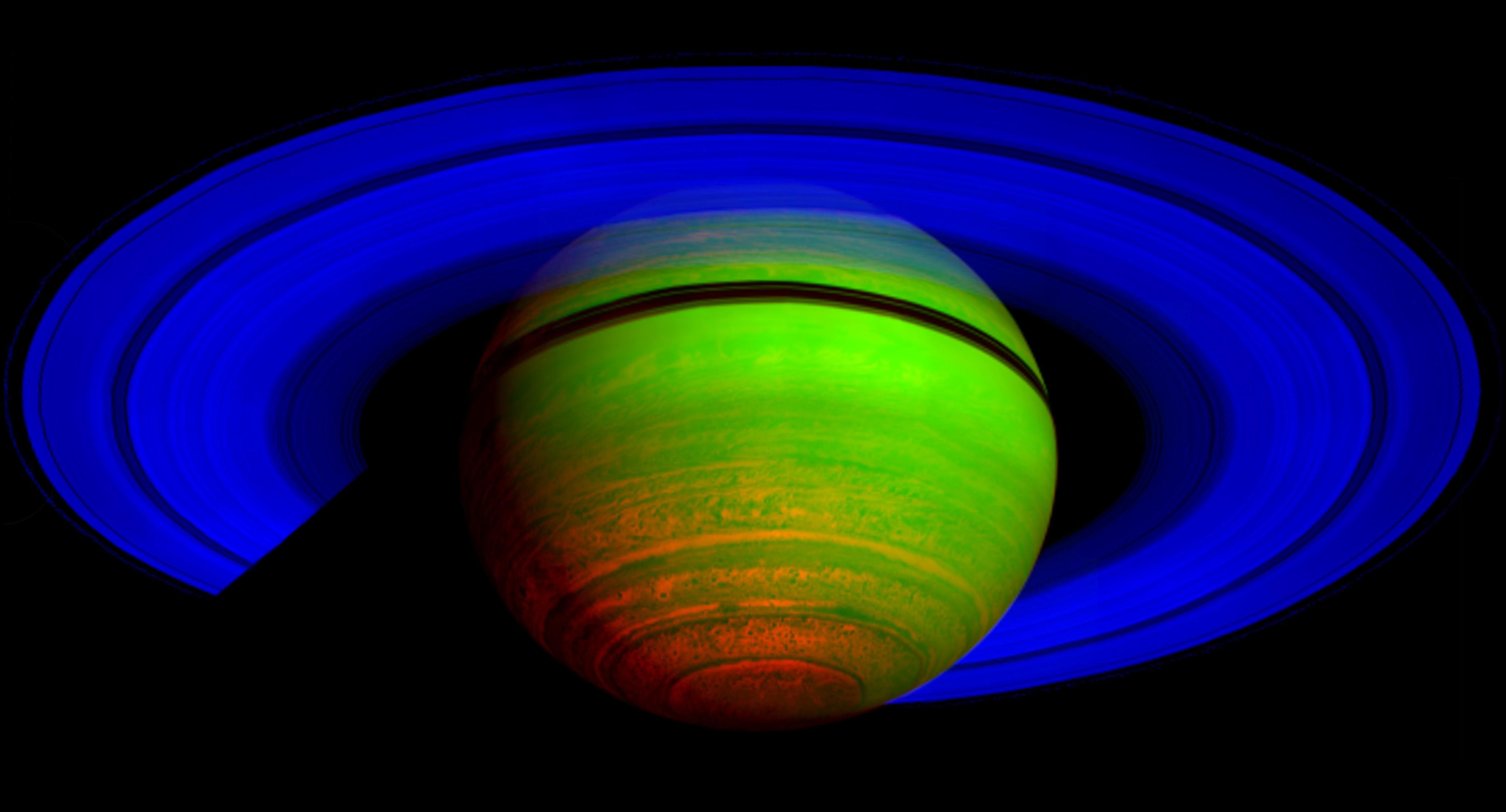NASA JPL | 2010-380 | 10 Nov 2010
Majestic Saturn, in the Infrared
This false-color composite image, constructed from data obtained by NASA's Cassini spacecraft, shows Saturn's rings and southern hemisphere. The composite image was made from 65 individual observations by Cassini's visual and infrared mapping spectrometer in the near-infrared portion of the light spectrum on Nov. 1, 2008. The observations were each six minutes long.
In this image constructed from data collected in the near-infrared wavelengths of light, scientists designated blue to indicate sunlight reflected at a wavelength of 2 microns, green to indicate sunlight reflected at 3 microns and red to indicate thermal emission at 5 microns. Saturn's rings reflect sunlight at 2 microns, but not at 3 and 5 microns, so they appear deep blue. Saturn's high altitude haze reflects sunlight at both 2 and 3 microns, but not at 5 microns, and so it appears green to blue-green. The heat emission from the interior of Saturn is only seen at 5 microns wavelength in the spectrometer data, and thus appears red. The dark spots and banded features in the image are clouds and small storms that outline the deeper weather systems and circulation patterns of the planet. They are illuminated from underneath by Saturn's thermal emission, and thus appear in silhouette.
Credit: NASA/JPL/ASI/University of Arizona
Saturn's emitted power - L Li et alLike a cosmic lightbulb on a dimmer switch, Saturn emitted gradually less energy each year from 2005 to 2009, according to observations by NASA's Cassini spacecraft. But unlike an ordinary bulb, Saturn's southern hemisphere consistently emitted more energy than its northern one. On top of that, energy levels changed with the seasons and differed from the last time a spacecraft visited Saturn in the early 1980s. These never-before-seen trends came from a detailed analysis of long-term data from the composite infrared spectrometer (CIRS), an instrument built by NASA's Goddard Space Flight Center in Greenbelt, Md., as well as a comparison with earlier data from NASA's Voyager spacecraft. When combined with information about the energy coming to Saturn from the sun, the results could help scientists understand the nature of Saturn's internal heat source.
...
The research, reported this week in the Journal of Geophysical Research-Planets, was led by Liming Li of Cornell University in Ithaca, N.Y. (now at the University of Houston).
...
The planets in our solar system lose energy in the form of heat radiation in wavelengths that are invisible to the human eye. The CIRS instrument picks up wavelengths in the thermal infrared region, far enough beyond red light where the wavelengths correspond to heat emission.
...
Instead, Saturn's flow of outgoing energy was lopsided, with its southern hemisphere giving off about one-sixth more energy than the northern one, Li explains. This effect matched Saturn's seasons: during those five Earth-years, it was summer in the southern hemisphere and winter in the northern one. (A season on Saturn lasts about seven Earth-years.) Like Earth, Saturn has these seasons because the planet is tilted on its axis, so one hemisphere receives more energy from the sun and experiences summer, while the other receives less energy and is shrouded in winter. Saturn's equinox, when the sun was directly over the equator, occurred in August 2009.
In the study, Saturn's seasons looked Earth-like in another way: in each hemisphere, its effective temperature, which characterizes its thermal emission to space, started to warm up or cool down as a change of season approached. The effective temperature provides a simple way to track the response of Saturn's atmosphere to the seasonal changes, which is complicated because Saturn's weather is variable and the atmosphere tends to retain heat. Cassini's observations revealed that the effective temperature in the northern hemisphere gradually dropped from 2005 to 2008 and started to warm up again by 2009. In the southern hemisphere, the effective temperature cooled from 2005 to 2009.
The emitted energy for each hemisphere rose and fell along with the effective temperature. Even so, during this five-year period, the planet as a whole seemed to be slowly cooling down and emitting less energy.
- Journal of Geophysical Research - Planets115 E11002 (2010) DOI: 10.1029/2010JE003631
